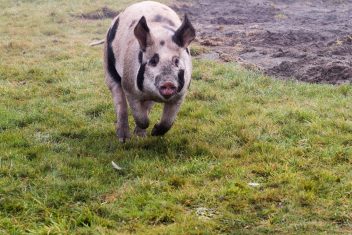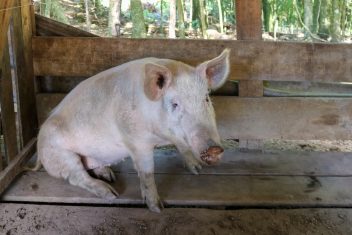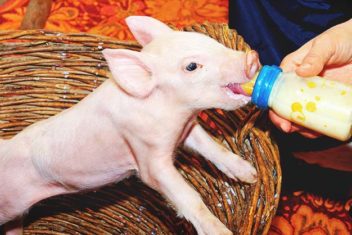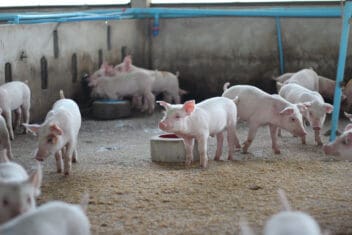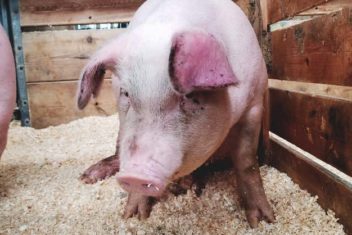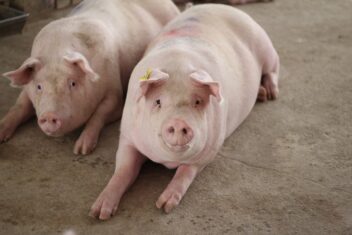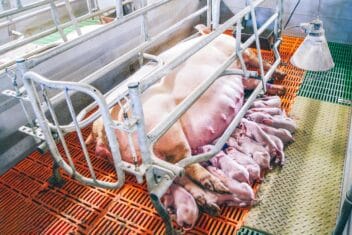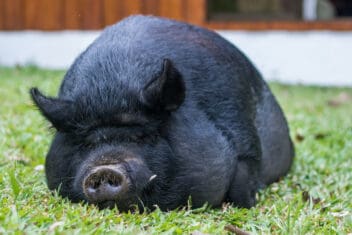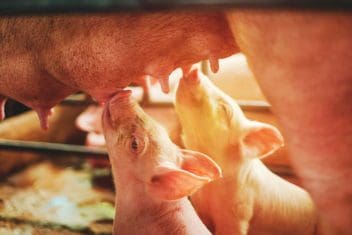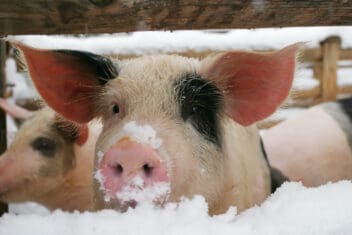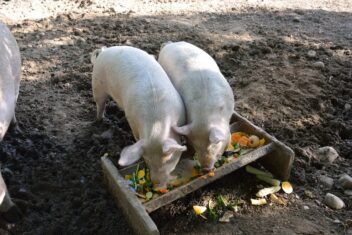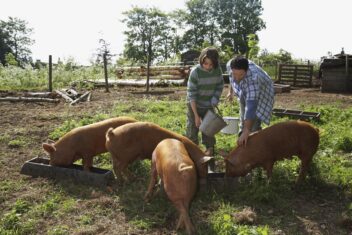Last summer, our sow came down with a mysterious ailment.
One day, seemingly without any kind of cause, she began limping, favoring her right back leg. After a few days, she stopped walking on it at all, and then she stopped eating.
Eventually, this led us to the assumption that she must have some kind of pig arthritis (yes, it does exist).
We began to panic, doing all that we could to research what the cause might be. I took endless trips down the Google rabbit hole and engaged in multiple failed attempts to locate any kind of injury to her leg. There didn’t seem to be any swelling, cuts, splinters, or anything else that could be causing her harm.
We tried treatment after treatment, spending weeks agonizing over what could possibly be wrong with her. We did our best to encourage her to eat by offering her favorite treats.
After several weeks of this, she was suddenly better.
To this date, we still have no idea what caused the mysterious case of the limping pig (wouldn’t that be a great title for a Nancy Drew book?). Since then, she seems to have completely healed. We can only surmise that she must have had a bad sprain that caused her immobility and lack of appetite for a while.
After this experience, however, I made it my mission to familiarize myself with some of the most common pig ailments. I never wanted to go down this road again!
I wanted to be a pig medical expert – well, as much of an expert that somebody without a veterinary degree (or really a science background at all) could be.
Knowing the signs and symptoms of some of the most common pig diseases – as well as how to treat and prevent them – is vital if you are raising pigs. Here’s what you need to know.
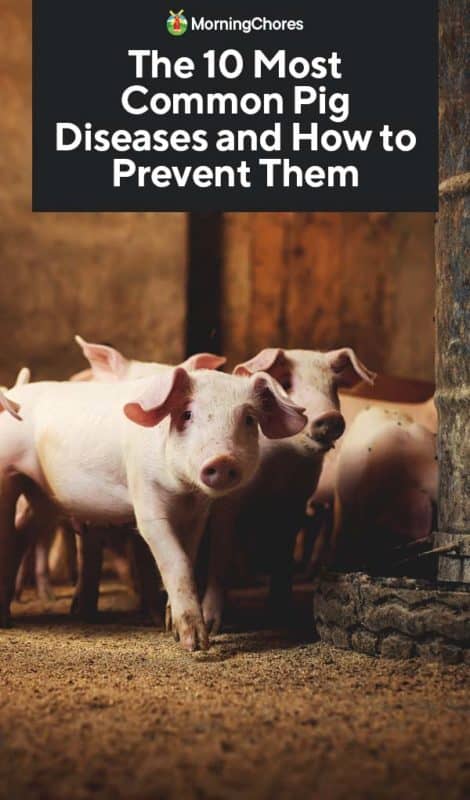
The 10 Most Common Pig Diseases
1. Coccidiosis

If you have chickens, you’ve probably already heard of coccidiosis. It’s common in suckling piglets, caused by three types of coccidia intracellular parasite.
The most telltale symptom of this pig disease is diarrhea. Often, this is bloody – just as it is in chickens. It occurs at around 10 to 21 days of age but can appear as late as 15 weeks of age. Usually, you can treat this disease with fluids and coccidiostats. However, since it often damages the wall of the intestines, it may become a chronic issue as other infections can occur.
It’s best to treat your sow prior to farrowing with coccidiostats. As with many of the diseases we’ll discuss, improving cleanliness on the farm can reduce or completely eliminate the likelihood of this disease. Feces is a major source of infection. Flies can also spread the infection.
2. Respiratory Diseases
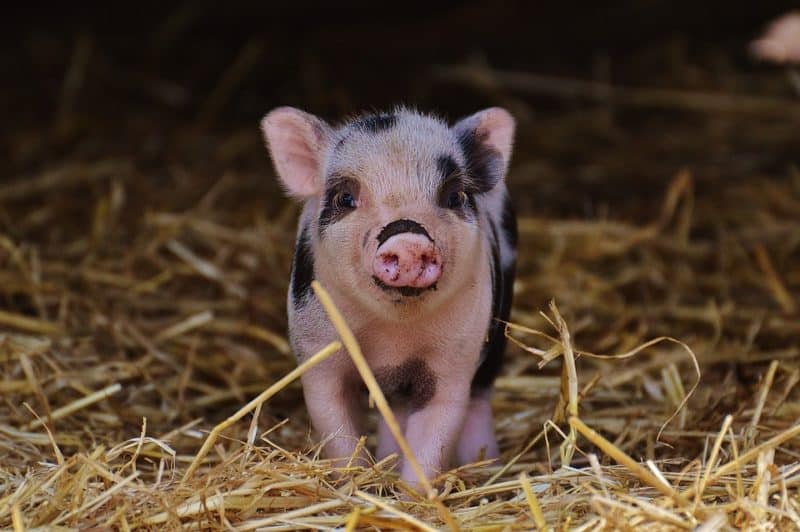
Pigs of all ages can develop respiratory diseases, but piglets that have just been weaned are the most likely to show problems. As with humans, the most common signs of respiratory infections are sneezing, coughing, lethargy, difficulty breathing, and slowed growth. Some serious infections can be fatal.
To prevent respiratory disease, make sure there is good ventilation in your barn. Again, these diseases are more common in certain environmental conditions. This includes dirty housing as well as overcrowded pens.
There are a number of causative agents involved in respiratory disease, including Pasteurella, Actinobacillus Pleuropneumoniae and Streptococcus Suis. Almost all are spread by poor hygiene.
There are some other steps you can take to reduce the likelihood of respiratory disease. For starters, quarantine any new pigs you introduce to the farm to make sure they are healthy. You should also be careful of the ammonia levels in your barn. These not only damage the respiratory tract but in doing so, make your pigs more prone to infections.
Respiratory illnesses can be fatal, so while preventing them is the best mode of treatment, if you believe your pigs are ill you may need to administer an antibiotic.
3. Swine Dysentery
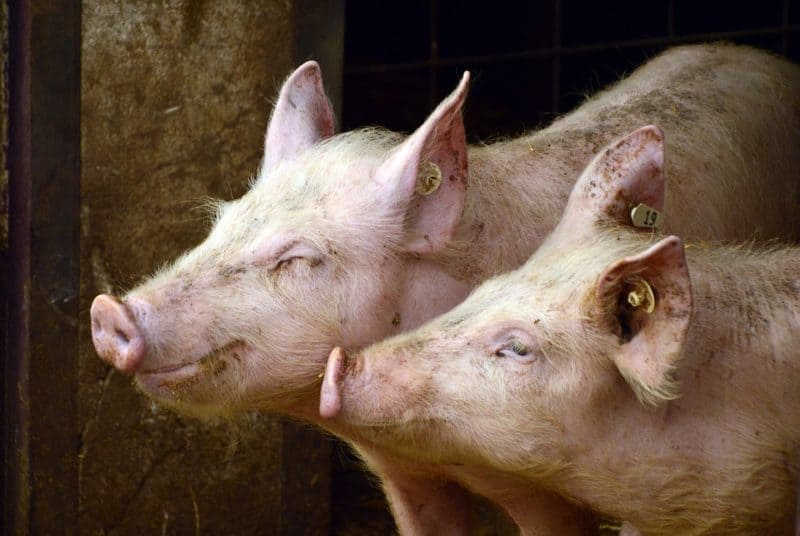
This is not a common pig disease except for hogs raised in confinement. However, it’s important to be aware of the signs nonetheless, especially if you regularly introduce new pigs to the farm.
This disease most commonly occurs post-weaning and causes diarrhea. It also causes a reduced growth rate and in severe cases, death. Spread by the bacteria Brachyspira Hyodysenteriae, this disease is usually only treated through antibiotics.
However, preventative methods are best. Reduce your stocking density, as overcrowding causes this disease to run rampant. You should only buy pigs from reputable sources and quarantine them upon arrival to the farm. Rodents are also vectors for this disease, so make sure you improve hygiene and engage in proper rodent control to keep this illness away.
4. Mastitis
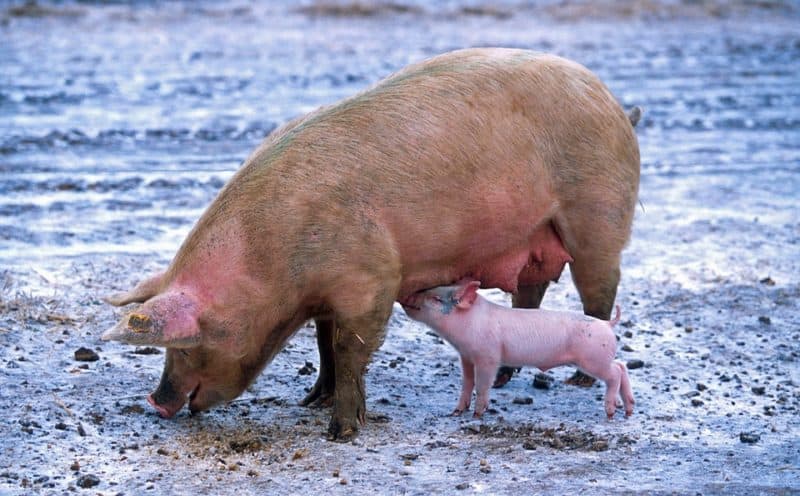
Mastitis is not a pig-exclusive disease, and instead, is a health problem that is common among all mammals. It’s present in breeding sows who are nursing or have just recently weaned.
This illness can cause reduced milk production, loss of appetite, and high body temperature. It’s caused by a bacterial infection in the mammary glands.
You might notice skin discoloration there as a result. Often, antibiotics and anti-inflammatory medications are used, but some veterinarians will combine oxytocin and corticosteroids to heal the area and to bring down the swelling.
Improving hygiene to reduce the spread of bacteria is vital, as is healthy nutrition both during and after pregnancy. Stress often causes mastitis, too.
5. Greasy Pig Disease
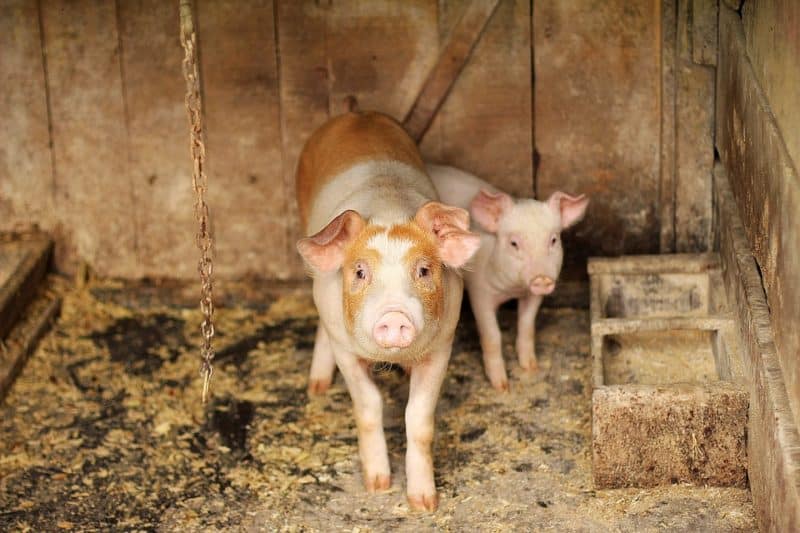
Don’t laugh! That’s actually the name of this disease, and it’s not just a colloquial term for a pig that’s been out too long in the summer sun.
Greasy pig disease, also known as exudative dermatitis, is caused by an infestation of the Staphylococcus Hyicus bacteria. Usually, it appears as dark lesions on the skin of your pig, which later spread and become flaky. Over time, they become – you guessed it – greasy.
Treatable with skin salves, antibiotics, and vaccines, the best way to prevent greasy pig disease is to improve the hygiene conditions in your barn. Because this disease usually manifests in young piglets prior to weaning, it’s best to perform teat dipping on your sows both pre- and post-farrowing.
Even though this disease spreads rapidly in unclean barns, you’re going to find that the mortality rate – and the rate of spread – is higher among pigs with numerous skin abrasions. Therefore, reducing the likelihood of cuts and scratches can be done by removing any rough flooring or sharp equipment. You may also need to clip the teeth of your piglets, as their sharp needle teeth can cause injury to their littermates.
6. Porcine Parvovirus
Porcine parvovirus is not common, but it can lead to reproductive diseases later on. This is the most common in gilts, causing small pig litters as well as mummification and stillborns. It is difficult to diagnose and often confused with other reproductive disorders.
It’s usually only a problem during pregnancy, but it can spread to other pigs and can live outside the host for several months. You can only prevent this virus by regularly vaccinating your gilts.
7. Parasites, Lice, and Flies
Parasites, lice, and flies are commonly found in pigs as they are in other livestock. Pig lice are large and easy to spot and diagnose. They cause serious amounts of blood loss and can lead to the spread of bacteria.
Flies, too, can be problematic, as they can enter into sores and open wounds and cause infection. You can treat both lice and flies with sprays, but maintaining a hygienic environment is paramount here.
Parasites are another issue. These are usually internal, residing in the gut or the muscle of your pigs. Young pigs are at the greatest risk of acquiring roundworms. These look just like worms and live in the gut of the pig. They can cause serious weight loss and you may find that the growth of your pigs is permanently reduced.
Tapeworms, on the other hand, live in the muscles of your pigs and cause pig measles. You may not notice any other symptoms in your pigs except that they have difficulty moving around. You can’t eat pork with tapeworms. It’s incredibly dangerous. Make sure you practice good hygiene in order to prevent tapeworms, roundworms, and other parasites on your farm.
8. Hog Cholera
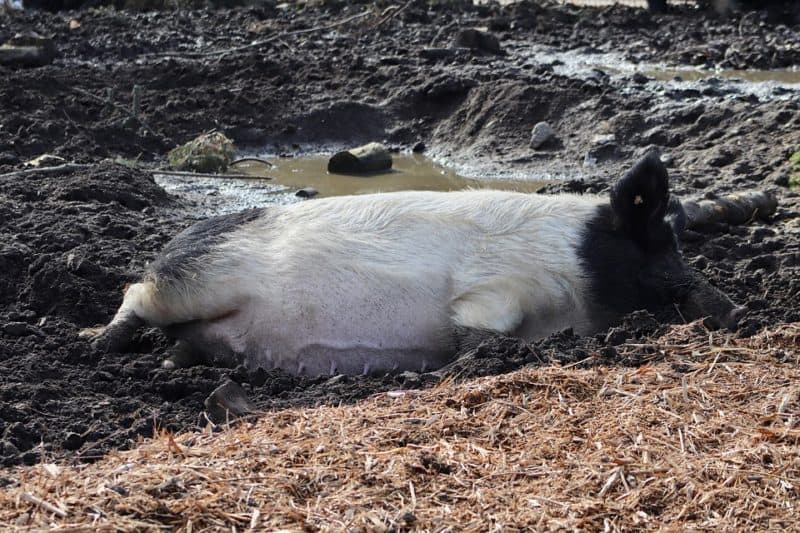
Also known as swine fever, hog cholera is one of the most common diseases on commercial hog farms. This is a virus that causes widespread disease and symptoms such as paralysis, diarrhea, lack of appetite, fever, abortion, and often, death. It only spreads from pig to pig. The virus doesn’t spread through the wind or via insects.
In areas where hog cholera is present, it is important that you vaccinate your herd. You should reduce visitors to the farm and not allow any pig meat near any pigs (this is a recommendation that should be followed regardless of the risk of disease). Any new pigs that you introduce to the farm should be quarantined.
Unfortunately, there is no treatment for hog cholera and affected animals often need to be euthanized.
9. Foot and Mouth Disease
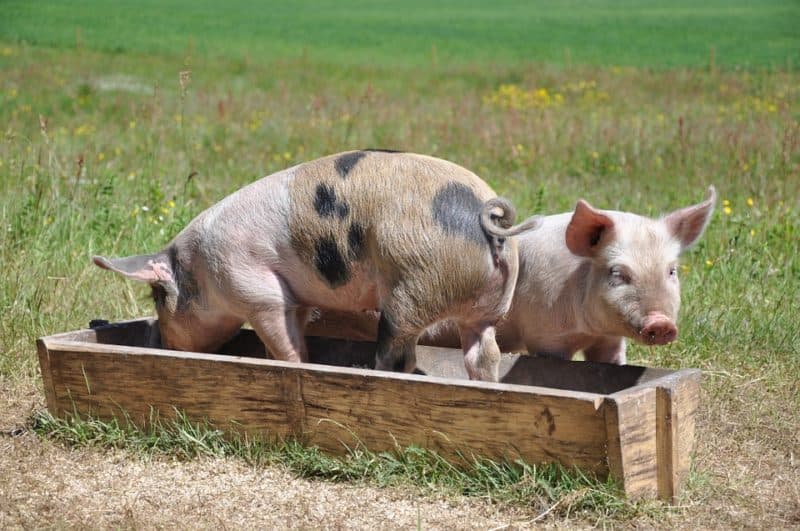
You’ve likely heard all about foot and mouth disease, and it’s important to know that it can occur in pigs as well as other farm animals like cattle, goats, and sheep.
Caused by a virus, foot and mouth disease causes fever, blisters, lameness, loss of appetite, excessive salivation, and death in many cases. You need to vaccinate your breeding stock to prevent foot and mouth disease, but keep in mind that it’s short-lived. Vaccination should be done regularly in the fall months.
10. Anemia
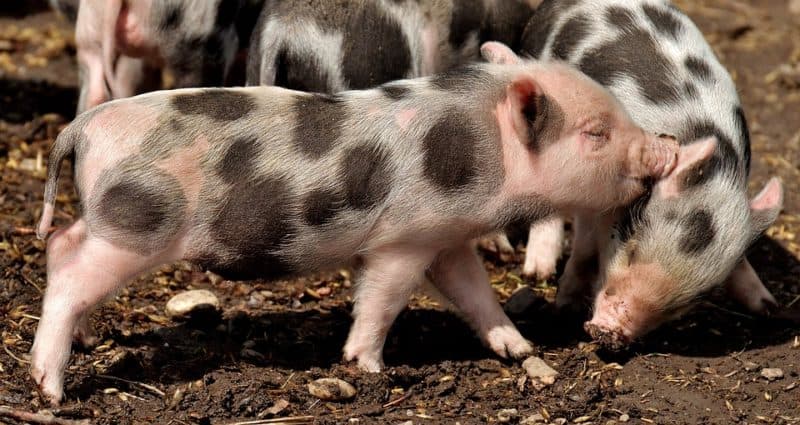
Anemia is associated with the reduction of red blood cells in the body. It can happen as the result of a hemorrhage (often occurring during farrowing) as well as, more commonly, dietary insufficiencies.
Anemia causes a variety of issues, including pale skin, rapid breathing, scours, weakness, and jaundice. It is most common in piglets and causes them to develop symptoms starting at about one week of age.
The easiest way to prevent anemia is to make sure your piglets are injected with 150-200 milligrams of iron dextran within a week of birth. Administer iron shots at three to five days of age, doing so in the hind leg or into the neck.
If your pigs become anemic later on, you can administer iron shots . However, the intestine absorbs iron and copper slowly and in small amounts, so providing these minerals might not be enough to completely reverse anemia. You may also need to supply electrolytes.
Tips for Preventing Disease
If you haven’t already figured it out by reading this article, preventing disease is much easier than trying to treat it. Many of the most common pig diseases aren’t easily reversed with treatment. For some, there are no treatments at all.
Therefore, making sure to vaccinate your pigs against any common illnesses is important. You should avoid bringing new animals onto the farm. If you do, make sure you quarantine them first to ensure they are fit and healthy.
As with raising all types of animals, make sure you provide the very best living conditions. House your pigs in clean quarters with plenty of fresh bedding, food, and after. It’s also important that you avoid malnutrition in pigs to prevent disease.
It’s not technically a pig disease, per se, but malnutrition is not only a common problem among pigs but also a major reason as to why they fail to thrive. If you can see the hips, backbones, or ribs of your pigs, they are too skinny. The only bones that should be visible on a pig are the shoulder blades.
Malnutrition often occurs as a result of poor quality or not enough feed. You need to provide extra feed to growing pigs as well as to lactating sows. Keep your pig feed clean to prevent contamination.
As with all livestock, while it’s important to be aware of the most common diseases, it’s always best to consult a veterinarian if your animals are ill. Many of the most common pig diseases share symptoms with other, less common ailments. In addition, more involved veterinary treatment might often be necessary to help your pig recover.

